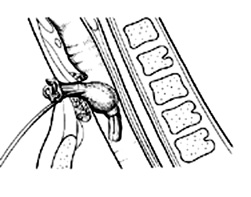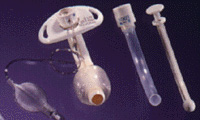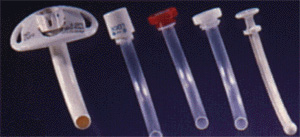Tracheotomy
What is a tracheotomy?
A tracheotomy is a surgical procedure in which an incision is made in the front of the neck and a breathing tube is placed into the trachea, also called the windpipe. The tube that is placed into the trachea is called a tracheotomy tube.
 This diagram shows a cross section of the tracheotomy tube in place. The front of the neck is to the left. This particular tracheotomy tube has a cuff, explained below.
This diagram shows a cross section of the tracheotomy tube in place. The front of the neck is to the left. This particular tracheotomy tube has a cuff, explained below.
Why is a tracheotomy performed?
A tracheotomy is done for a variety of different reasons. If there is an emergency and the normal airway is blocked by swelling or blood, a tracheotomy must be performed quickly to re-establish the airway. A tracheotomy is often done before major surgery in the throat or mouth because swelling after the operation will interfere with breathing. Individuals who are unable to breathe for themselves and must be on a ventilator for a long period of time often are more comfortable and more easily cared with a tracheotomy. Patients with severe sleep apnea sometimes require a tracheotomy so they can breathe easily at night.
For how long will I need a tracheotomy tube?
The length of time a tracheotomy tube stays in place depends on why it was required. If the tube was placed to bypass a swollen upper throat, it will need to stay in place until the swelling has gone down. In some cases this may just be a few days, but it could be needed for many months. For individuals on a ventilator or with severe apnea, the tracheotomy tube may need to stay in indefinitely.
Cuffed and uncuffed tracheotomy tubes
 When inflated, the cuff presses against the tracheal wall to prevent air leakage and loss of pressure from the patent’s lungs. The cuff also helps to prevent saliva and other secretions and swallowed liquids from getting into the lungs. Most tracheotomy tubes have an inner cannula (thin tube) that slides within the outer tube. The inner tube is the middle tube in the picture to the right. The advantage of having an inner tube is that if a plug of mucous blocks the inner tube, it can be easily removed to unblock the airway. The tube on the right is called an introducer or a stylet. It is used to help introduce the trachea into the opening in the neck.
When inflated, the cuff presses against the tracheal wall to prevent air leakage and loss of pressure from the patent’s lungs. The cuff also helps to prevent saliva and other secretions and swallowed liquids from getting into the lungs. Most tracheotomy tubes have an inner cannula (thin tube) that slides within the outer tube. The inner tube is the middle tube in the picture to the right. The advantage of having an inner tube is that if a plug of mucous blocks the inner tube, it can be easily removed to unblock the airway. The tube on the right is called an introducer or a stylet. It is used to help introduce the trachea into the opening in the neck.
 For people who do not need to be on a ventilator, the cuff can be deflated or an uncuffed tube can be used. In the photo to the left, a typical uncuffed tube used for adults is seen on the left side. The clear tubes with the white caps are examples of inner cannulas. The tube with the red cap is used to plug the trach and test if the trach can be removed (explained below).
For people who do not need to be on a ventilator, the cuff can be deflated or an uncuffed tube can be used. In the photo to the left, a typical uncuffed tube used for adults is seen on the left side. The clear tubes with the white caps are examples of inner cannulas. The tube with the red cap is used to plug the trach and test if the trach can be removed (explained below).
Can I speak with a tracheotomy?
If the tube is uncuffed and the upper airway is not swollen, you can speak with a tracheotomy tube by covering the tube opening with a finger while speaking. Some companies also make a valve that fits on the end of the tracheotomy tube so that it doesn't have to covered when speaking. One example of this is called a Passey-Muir valve. This is a one-way valve that allows air to pass in through the trach, however, all exhaled air goes up through the vocal folds and out the mouth.
How do I care for a tracheotomy?
Most tracheotomy tubes have an inner tube called an inner cannula that should be cleaned whenever it gets blocked with secretions. This can vary from once to many times per day, depending on the individual. The outer tube should be changed every several months, and the site should be inspected. Someone with a new tracheotomy will require a humidifier attachment to the tracheotomy tube for about one month, because the windpipe will be exposed to much drier air than usual.
What happens when the tracheotomy tube is removed?
A tracheotomy tube can be removed if breathing or the airway improves enough so that the tube is no longer needed. The easiest way to test whether a tracheotomy tube is needed is to put a plug over the opening. If the trach can be plugged for a long enough time without any problems, it is probably safe to be removed. The trach tube will simply slide out and the opening in the neck should close on its own in about one week. During the time the trach is out but before the hole has closed, air will leak out when the individual talks. It is therefore best to tightly cover the opening when talking or coughing. In some cases, the opening does not close, and a small surgical procedure must be done to close it. Also, sometimes the trach scar must be revised as it can be quite prominent.
